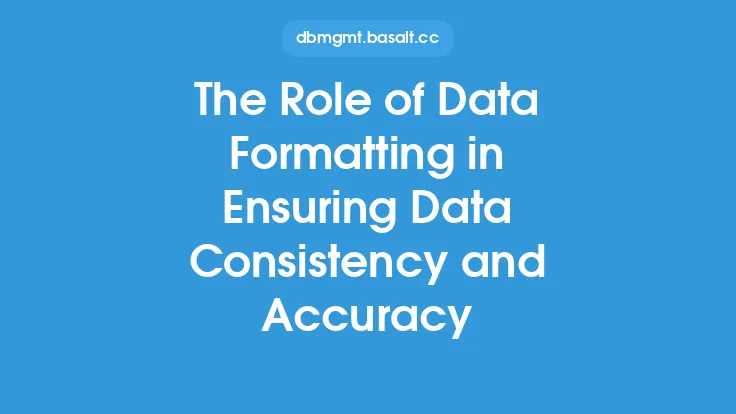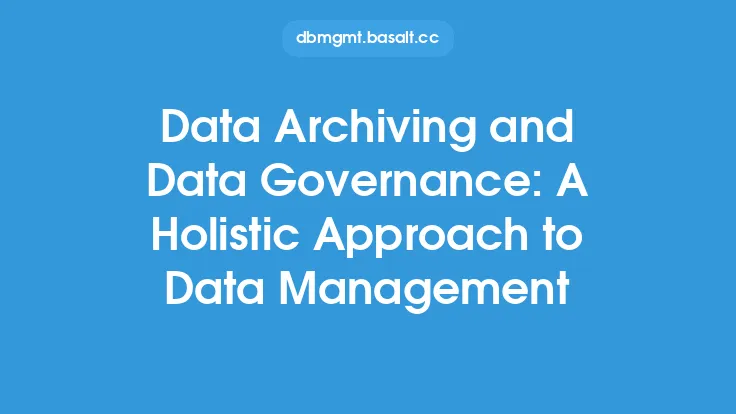Data formatting is a crucial aspect of data normalization, as it ensures that data is presented in a consistent and standardized manner. This consistency is essential for efficient data processing, analysis, and reporting. In this article, we will delve into the world of data formatting standards and conventions, exploring the various guidelines and best practices that govern this field.
Introduction to Data Formatting Standards
Data formatting standards are a set of rules and guidelines that dictate how data should be presented and formatted. These standards are designed to ensure that data is consistent, accurate, and easily readable. They cover a wide range of aspects, including date and time formats, numeric formats, string formats, and more. By following these standards, organizations can ensure that their data is consistent across different systems, applications, and departments.
Date and Time Formatting Conventions
Date and time formatting is a critical aspect of data formatting. The most commonly used date and time formatting conventions are the ISO 8601 standard, which specifies that dates should be formatted as YYYY-MM-DD, and times should be formatted as HH:MM:SS. This standard is widely adopted and provides a consistent way of representing dates and times. Additionally, there are other formatting conventions, such as the RFC 3339 standard, which is used for internet applications.
Numeric Formatting Conventions
Numeric formatting conventions govern how numbers are presented and formatted. The most commonly used numeric formatting conventions include the use of commas as thousand separators, decimal points to separate the integer and fractional parts of a number, and the use of scientific notation to represent very large or very small numbers. These conventions are essential for ensuring that numeric data is easily readable and understandable.
String Formatting Conventions
String formatting conventions dictate how text data is presented and formatted. The most commonly used string formatting conventions include the use of uppercase and lowercase letters, the use of punctuation marks, and the use of special characters. These conventions are essential for ensuring that text data is consistent and easily readable.
Data Type Formatting Conventions
Data type formatting conventions govern how different data types are presented and formatted. The most commonly used data types include integers, floating-point numbers, strings, and dates. Each data type has its own set of formatting conventions, which are designed to ensure that the data is consistent and easily readable. For example, integer data types are typically formatted without decimal points, while floating-point numbers are formatted with decimal points.
Cultural and Linguistic Considerations
Data formatting standards and conventions can vary across different cultures and languages. For example, the format for dates and times can differ significantly between different countries and regions. Additionally, the use of punctuation marks and special characters can also vary. It is essential to consider these cultural and linguistic differences when formatting data, to ensure that the data is easily readable and understandable by users from diverse backgrounds.
Industry-Specific Data Formatting Standards
Different industries have their own set of data formatting standards and conventions. For example, the financial industry has its own set of standards for formatting financial data, such as stock prices and trading volumes. The healthcare industry also has its own set of standards for formatting medical data, such as patient records and medical test results. These industry-specific standards are designed to ensure that data is consistent and easily readable within each industry.
Best Practices for Implementing Data Formatting Standards
Implementing data formatting standards requires careful planning and attention to detail. The following are some best practices for implementing data formatting standards: establish a clear set of standards and conventions, use automated tools to enforce these standards, provide training and support to users, and regularly review and update the standards to ensure they remain relevant and effective.
Tools and Technologies for Data Formatting
There are a variety of tools and technologies available for data formatting, including data validation software, data transformation software, and data quality software. These tools can help automate the data formatting process, ensuring that data is consistent and accurate. Additionally, programming languages such as Python and R provide libraries and functions for data formatting, making it easier to implement data formatting standards and conventions.
Conclusion
In conclusion, data formatting standards and conventions are essential for ensuring that data is consistent, accurate, and easily readable. By following these standards and conventions, organizations can ensure that their data is consistent across different systems, applications, and departments. It is essential to consider cultural and linguistic differences, as well as industry-specific standards, when formatting data. By implementing data formatting standards and using the right tools and technologies, organizations can improve the quality and usability of their data, leading to better decision-making and improved business outcomes.





